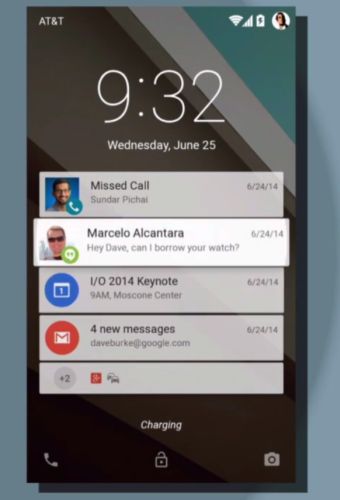Google Releases Android L Preview Source Code For Nexus 5
In an effort to encourage and help developers produce apps for the successor to Android KitKat, Google has released the Android L Preview Source Code for the Nexus 5, Nexus 7, and Nexus 10.
It’s important to note that this is simply a Preview Source Code for the next generation of Google’s Android operating system; therefore, it contains limited utility from a developer’s standpoint. AndroidPolice stresses that the Android L Preview Code does not contain binary packages or kernal sources. Technical jargon aside, this basically means that custom ROM developers are out of luck — at least for the time being.
So, what kind of changes can you expect to see in the next generation of Google’s Android operating system? The Android L Preview Source Code reveals a revamped user interface with a new notification system (see photo above). The Mountain View company describes its new user interface as a material design, the new “Google-wide standard.” This new user interface is clean, smooth, and focused around simplicity.
The Android L Preview Source Code also depicts new customization options regarding notifications. Users will have more control over where notifications appear on their device, how notifications look (e.g. icon designs), and how they connect with other non-handheld devices. Google wants to create a positive experience with cross-compatibility technology, allowing its users to sync different devices together.
Another notable feature found in the Android L Preview Source Code is Project Volta — a system which provides users with greater control over their device’s energy usage. The Nexus line of smartphones and tablets are known for being energy efficient, but Google is pushing for even greater energy efficiency with its Project Volta. According to a test run conducted by Ars Technica, Project Volta could yield as much as 30% additional battery power.
Google published the following statement about the Android L Preview Source code on its official Android.com website:
“The L Developer Preview gives you an advance look at the upcoming release for the Android platform, which offers new features for users and app developers. This document provides an introduction to the most notable APIs.
The L Developer Preview is intended for developer early adopters and testers. If you are interested in influencing the direction of the Android framework, give the L Developer Preview a try and send us your feedback!”
There’s been no official word yet on when Android L will be released to the public; however, some analysts predict the company will release it in the fourth quarter of this year.
What are your thoughts on Android L? Let us know in the comments section below!










